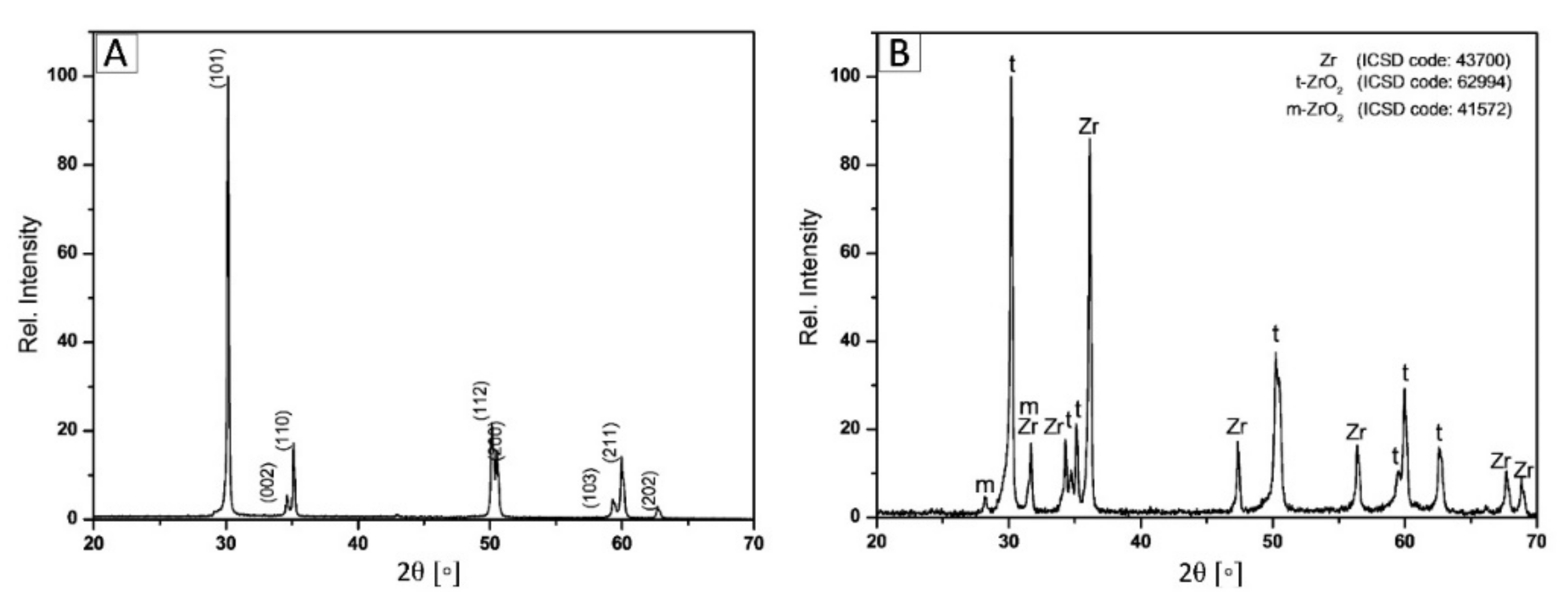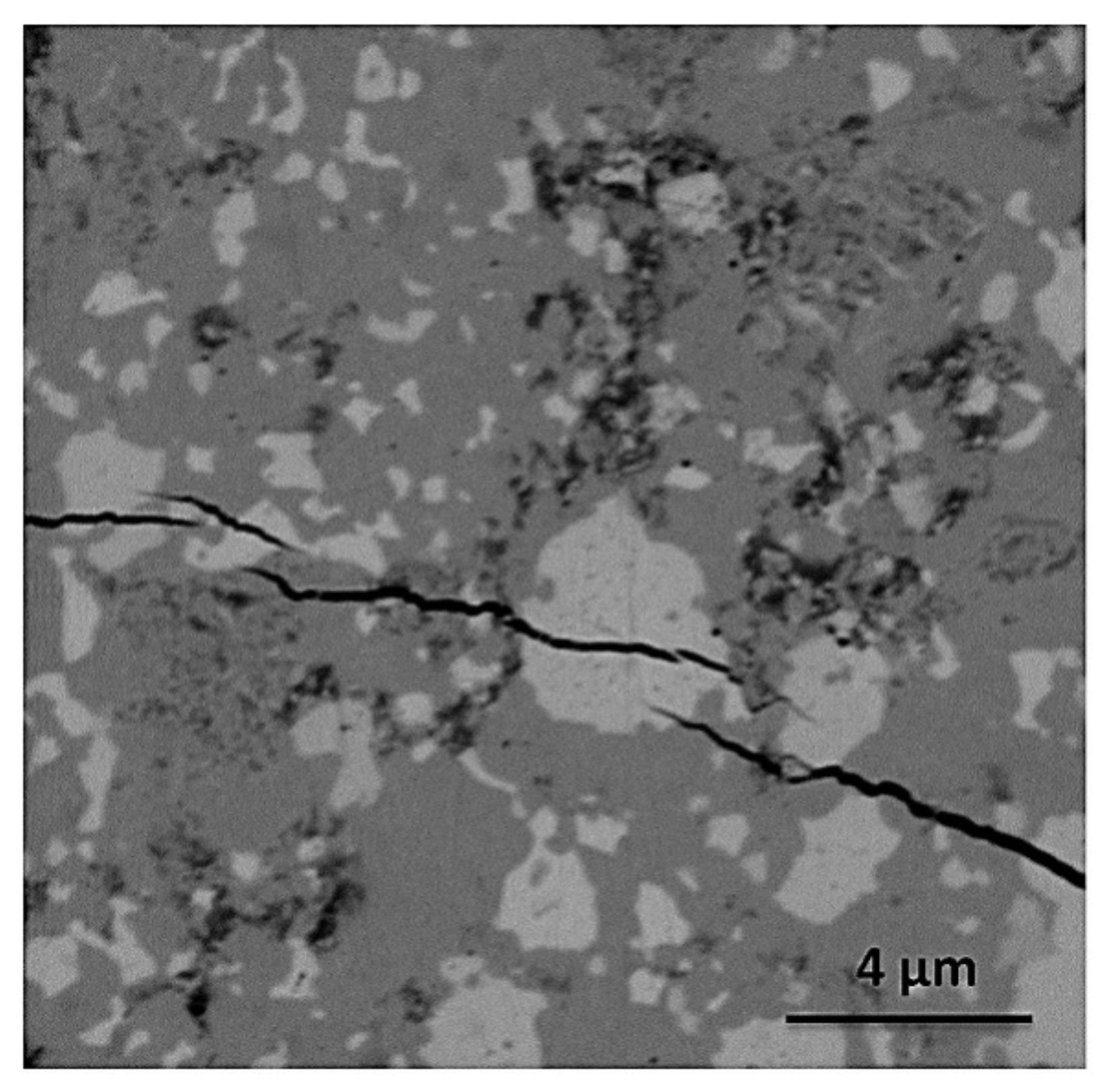Microstructure and Mechanical Properties of Zirconia (3Y-TZP)/Zr Composites Prepared by Wet Processing and Subsequent Spark Plasma Sintering
Abstract
:1. Introduction
2. Experimental Procedures
2.1. Starting Materials
2.2. Powder Processing
2.3. XRD Characterization
2.4. Microstructural Characterization
2.5. Mechanical Characterization
3. Results and Discussion
3.1. XRD Study
3.2. Microstructure Study
3.3. Mechanical Properties
4. Conclusions
Author Contributions
Funding
Conflicts of Interest
References
- Kameo, K.; Friedrich, K.; Bartolome, J.F.; Diaz, M.; Lopez-Esteban, S.; Moya, J.S. Sliding wear of ceramics and cermets against steel. J. Eur. Ceram. Soc. 2003, 23, 2867–2877. [Google Scholar] [CrossRef]
- Bartolome, J.F.; Montero, I.; Diaz, M.; Lopez-Esteban, S.; Moya, J.S. Accelerated aging in 3-mol%-yttria-stabilized tetragonal zirconia ceramics sintered in reducing conditions. J. Am. Ceram. Soc. 2004, 12, 2282–2285. [Google Scholar] [CrossRef]
- Smirnov, A.; Kurland, H.-D.; Grabow, J.; Müller, F.A.; Bartolome, J.F. Microstructure, mechanical properties and low temperature degradation resistance of 2Y-TZP ceramic materials derived from nanopowders prepared by laser vaporization. J. Eur. Ceram. Soc. 2015, 35, 2685–2691. [Google Scholar] [CrossRef]
- Soon, G.; Pingguan-Murphy, B.; Lai, K.W.; Akbar, S.A. Review of zirconia-based bioceramic: Surface modification and cellular response. Ceram. Inter. 2016, 42, 12543–12555. [Google Scholar] [CrossRef]
- Rodriguez-Suarez, T.; Bartolome, J.F.; Moya, J.S. Mechanical and tribological properties of ceramic/metal composites: A review of phenomena spanning from the nanometer to the micrometer length scale. J. Eur. Ceram. Soc. 2012, 32, 3887–3898. [Google Scholar] [CrossRef]
- Moya, J.S.; Diaz, M.; Gutierrez-Gonzalez, C.F.; Diaz, L.A.; Torrecillas, R.; Bartolomé, J.F. Mullite-refractory metal (Mo, Nb) composites. J. Eur. Ceram. Soc. 2008, 28, 479–491. [Google Scholar] [CrossRef]
- Rodriguez-Suarez, T.; Lopez-Esteban, S.; Bartolome, J.F.; Moya, J.S. Mechanical properties of alumina-rich magnesium aluminate spinel/tungsten composites. J. Eur. Ceram. Soc. 2007, 27, 3339–3344. [Google Scholar] [CrossRef]
- Bartolome, J.F.; Beltran, J.I.; Gutierrez-Gonzalez, C.F.; Pecharromán, C.; Muñoz, M.C.; Moya, J.S. Influence of ceramic-metal interface adhesion on crack growth resistance of ZrO2-Nb ceramic matrix composites. Acta Mater. 2008, 56, 3358–3366. [Google Scholar] [CrossRef]
- Bartolome, J.F.; Diaz, M.; Moya, J.S. Influence of the metal particle size on the crack growth resistance in mullite-molybdenum composites. J. Am. Ceram. Soc. 2002, 85, 2778–2784. [Google Scholar] [CrossRef]
- Bartolome, J.F.; Diaz, M.; Moya, J.S.; Saiz, E.; Tomsia, A.P. Mullite/Mo interfaces formed by intrusion bonding. J. Eur. Ceram. Soc. 2004, 24, 785–790. [Google Scholar] [CrossRef] [Green Version]
- Smirnov, A.; Beltrán, J.I.; Rodriguez-Suarez, T.; Pecharromán, C.; Muñoz, M.C.; Moya, J.S.; Bartolomé, J.F. Unprecedented simultaneous enhancement in flaw tolerance and fatigue resistance of zirconia–Ta composites. Sci. Rep. 2017, 7, 44922. [Google Scholar] [CrossRef] [PubMed] [Green Version]
- Diaz, M.; Bartolome, J.F.; Requena, J.; Moya, J.S. Wet processing of mullite/molybdenum composites. J. Eur. Ceram. Soc. 2000, 20, 1907–1914. [Google Scholar] [CrossRef]
- Pecharroman, C.; Lopez-Esteban, S.; Bartolome, J.F.; Moya, J.S. Evidence of nearest-neighbor ordering in wet-processed zirconia-nickel composites. J. Am. Ceram. Soc. 2001, 84, 2439–2441. [Google Scholar] [CrossRef]
- Smirnov, A.; Peretyagin, P.; Bartolome, J.F. Processing and mechanical properties of new hierarchical metal-graphene flakes reinforced ceramic matrix composites. J. Eur. Ceram. Soc. 2019, 39, 3491–3497. [Google Scholar] [CrossRef]
- Fernandez-Garcia, E.; Gutierrez-Gonzalez, C.F.; Fernandez, A.; Torrecillas, R.; Lopez-Esteban, S. Processing and Spark Plasma Sintering of zirconia/titanium cermets. Ceram. Inter. 2013, 39, 6931–6936. [Google Scholar] [CrossRef]
- Gutierrez-Gonzalez, C.F.; Smirnov, A.; Bartolome, J.F. Aging effect on the tribological behavior of a novel 3Y-TZP/Nb biocomposite against ultra high molecular weight polyethylene. J. Am. Ceram. Soc. 2012, 95, 851–854. [Google Scholar] [CrossRef] [Green Version]
- Fernandez-Garcia, E.; Guillem-Martí, J.; Gutierrez-Gonzalez, C.F.; Fernandez, A.; Ginebra, M.P.; Esteban, L. Osteoblastic cell response to spark plasma-sintered zirconia/titanium cermets. J. Biomater. 2014, 29, 813–823. [Google Scholar] [CrossRef]
- Bartolomé, J.F.; Moya, J.S.; Couceiro, R.; Gutierrez-Gonzalez, C.F.; Guitián, F.; Martínez-Insua, M. In vitro and in vivo evaluation of a new zirconia/niobium biocermet for hard tissue replacement. J. Biomater. 2016, 76, 313–320. [Google Scholar] [CrossRef]
- Smirnov, A.; Gutierrez-Gonzalez, C.F.; Bartolomé, J.F. Cyclic fatigue life- and crack-growth behavior of zirconia-niobium composites. J. Am. Ceram. Soc. 2013, 96, 1709–1712. [Google Scholar] [CrossRef]
- Gutierrez-Gonzalez, C.F.; Moya, J.S.; Palomares, F.J.; Bartolomé, J.F. Low-temperature aging degradation-free 3Y-TZP/Nb composites. J. Am. Ceram. Soc. 2010, 93, 1842–1844. [Google Scholar] [CrossRef]
- Smirnov, A.; Bartolomé, J.F. Microstructure and mechanical properties of ZrO2 ceramics toughened by 5–20 vol% Ta metallic particles fabricated by pressureless sintering. Ceram. Int. 2014, 40, 1829–1834. [Google Scholar] [CrossRef]
- Smirnov, A.; Bartolomé, J.F. Mechanical properties and fatigue life of ZrO2–Ta composites prepared by hot pressing. J. Eur. Ceram. Soc. 2012, 32, 3899–3904. [Google Scholar] [CrossRef]
- Virkar, A.V.; Johnson, D.L. Fracture behavior of ZrO2-Zr composites. J. Am. Ceram. Soc. 1977, 60, 514–519. [Google Scholar] [CrossRef]
- Virkar, A.V.; Johnson, D.L. Wetting Characteristics of Zr with ZrO2-x. J. Am. Ceram. Soc. 1977, 60, 85. [Google Scholar] [CrossRef]
- Smirnov, A.; Peretyagin, P.; Bartolomé, J.F. Wire electrical discharge machining of 3Y-TZP/Ta ceramic-metal composites. Alloys Compd. 2018, 739, 62–68. [Google Scholar] [CrossRef]
- Esteban-Tejeda, L.; Smirnov, A.; Prado, C.; Moya, J.S.; Torrecillas, R.; Bartolomé, J.F. Multifunctional ceramic-metal biocomposites with Zinc containing antimicrobial glass coatings. Ceram. Int. 2016, 42, 7023–7029. [Google Scholar] [CrossRef]
- Smirnov, A.; Volosova, M.; Peretyagin, P.; Bartolomé, J.F. Tribological behaviour of a 3Y-TZP/Ta ceramic-metal biocomposite against ultrahigh molecular weight polyethylene (UHMWPE). Ceram. Int. 2018, 44, 1404–1410. [Google Scholar] [CrossRef]
- Mishina, H.; Tomoki, K.; Ikegami, H.; Ohishi, R.; Hase, A. Mechanical and biotribological properties of ceramic–metal composites (TiC/Ti–15Mo and SiC/Ti–15Mo) for joint prostheses and the effects of additive metallic elements of W, Nb, and Ir. Mater. Sci. Eng. A. 2012, 549, 38–42. [Google Scholar] [CrossRef]
- Thomson, K.E.; Jiang, D.; Yao, W.; Ritchie, R.O.; Mukherjee, A.K. Characterization and mechanical testing of alumina-based nanocomposites reinforced with niobium and/or carbon nanotubes fabricated by spark plasma sintering. Acta Mater. 2012, 60, 622–632. [Google Scholar] [CrossRef]
- Miracle, D.B.; Donaldson, S.L. (Eds.) ASM Handbook, 10th ed.; ASM International: Cleveland, OH, USA, 2001. [Google Scholar]
- Mehjabeen, A.; Song, T.; Wei, X.; Ping, H.; Qian, T.; Qian, M. Zirconium alloys for orthopaedic and dental applications. Adv. Eng. Mat. 2018, 20, 1800207. [Google Scholar] [CrossRef]
- Garvie, R.C.; Nicholson, P.S. Phase analysis in zirconia systems. J. Am. Ceram. Soc. 1972, 55, 303–305. [Google Scholar] [CrossRef]
- Toraya, H.; Yoshimura, M.; Somiya, S. Calibration curve for quantitative analysis of the monoclinic tetragonal ZrO2 system by X-ray diffraction. J. Am. Ceram. Soc. 1984, 67, 119–121. [Google Scholar]
- Wurst, J.C.; Nelson, J.A. Lineal intercept technique for measuring grain size in two-phase polycrystalline ceramics. J. Am. Ceram. Soc. 1972, 55, 109. [Google Scholar] [CrossRef]
- Taya, M.; Hayashi, S.; Kobayashi, A.S.; Yoon, H.S. Toughening of a particulate-reinforced ceramic-matrix composites by thermal residual stress. J. Am. Ceram. Soc. 1990, 73, 1382–1391. [Google Scholar] [CrossRef]
- Siffert, B.; Jada, A.; Eleli Letsango, J. Location of the shear plane in the electrical double layer in an organic medium. J. Colloid. Interf. Sci. 1994, 163, 327–333. [Google Scholar] [CrossRef]
- Menon, M.; Decourcelle, S.; Ramousse, S.; Halvor Larsen, P. Stabilization of ethanol-based alumina suspensions. J. Am. Ceram. Soc. 2006, 89, 457–464. [Google Scholar] [CrossRef]
- Widegren, J.; Lennart Bergström, L. The effect of acids and bases on the dispersion and stabilization of ceramic particles in ethanol. J. Eur. Ceram. Soc. 2000, 20, 659–665. [Google Scholar] [CrossRef]
- Farrokhi-rad, M.; Ghorbani, M. Stability of titania nano-particles in different alcohols. Ceram. Int. 2012, 38, 3893–3900. [Google Scholar] [CrossRef]
- Heijman, S.G.J.; Stein, H.N. Electrostatic and steric stabilization of TiO2 dispersions. Langmuir 1995, 11, 422–427. [Google Scholar] [CrossRef] [Green Version]
- Moreno, M.; Requena, J.; Moya, J.S. Slip Casting of Yttria-Stabilized Tetragonal Zirconia Polycrystals. J. Am. Ceram. Soc. 1988, 71, 1036–1040. [Google Scholar] [CrossRef]
- Damodaran, R.; Mougdil, B.M. Electrophoretic deposition of calcium phosphates from non-aqueous media. Colloids Surf. A: Physicochem. Eng. Aspects. 1993, 80, 191–195. [Google Scholar] [CrossRef]
- Chandrasekar, S. Stochastic problems in physics and astronomy. Rev. Mod. Phys. 1943, 15, 1–89. [Google Scholar] [CrossRef]
- Lide, D.R. Handbook of Chemistry and Physics, 85th ed.; CRC Press: Boca Raton, FL, USA, 2004. [Google Scholar]
- Kim, H.S. On the rule of mixtures for the hardness of particle reinforced composites. Materials Science and Engineering A. 2000, 289, 30–33. [Google Scholar] [CrossRef]
- Raceanu, L.; Optasanu, V.; Montesin, T.; Montay, G.; Francois, M. Shot-peening of pre-oxidized plates of zirconium: Influence of residual stress on oxidation. Oxid. Met. 2013, 79, 135–145. [Google Scholar] [CrossRef]
- Ashby, M.F.; Blunt, F.J.; Bannister, M. Flow characteristic of highly constrained metal wires. Acta. Metall. 1989, 37, 1847–1857. [Google Scholar] [CrossRef]




| Specimen | Density [% th] | Young’s Modulus E [GPa] | Flexural Strength σf [MPa] | Hardness HV [GPa] | Fracture Toughness KIc [MPa·m1/2] | Volume Fractions of t- and m-ZrO2 [vol%] | Transformability of t-ZrO2 Vtrans | |||
|---|---|---|---|---|---|---|---|---|---|---|
| Polished | Fractured | |||||||||
| t | m | t | m | |||||||
| ZrO2 | 99 | 199 ± 4 | 1071 ± 99 | 14.4 ± 0.3 | 3.8 ± 0.1 | 99 | 1 | 98 | 2 | 1 |
| ZrO2/Zr | 98 | 166 ± 5 | 825 ± 63 | 12.8 ± 0.2 | 4.1 ± 0.1 | 89 | 11 | 87 | 13 | 2 |
© 2020 by the authors. Licensee MDPI, Basel, Switzerland. This article is an open access article distributed under the terms and conditions of the Creative Commons Attribution (CC BY) license (http://creativecommons.org/licenses/by/4.0/).
Share and Cite
Díaz, M.; Smirnov, A.; Gutiérrez-González, C.F.; Estrada, D.; Bartolomé, J.F. Microstructure and Mechanical Properties of Zirconia (3Y-TZP)/Zr Composites Prepared by Wet Processing and Subsequent Spark Plasma Sintering. Ceramics 2020, 3, 53-64. https://doi.org/10.3390/ceramics3010007
Díaz M, Smirnov A, Gutiérrez-González CF, Estrada D, Bartolomé JF. Microstructure and Mechanical Properties of Zirconia (3Y-TZP)/Zr Composites Prepared by Wet Processing and Subsequent Spark Plasma Sintering. Ceramics. 2020; 3(1):53-64. https://doi.org/10.3390/ceramics3010007
Chicago/Turabian StyleDíaz, Marcos, Anton Smirnov, C.F. Gutiérrez-González, Diana Estrada, and José F. Bartolomé. 2020. "Microstructure and Mechanical Properties of Zirconia (3Y-TZP)/Zr Composites Prepared by Wet Processing and Subsequent Spark Plasma Sintering" Ceramics 3, no. 1: 53-64. https://doi.org/10.3390/ceramics3010007
APA StyleDíaz, M., Smirnov, A., Gutiérrez-González, C. F., Estrada, D., & Bartolomé, J. F. (2020). Microstructure and Mechanical Properties of Zirconia (3Y-TZP)/Zr Composites Prepared by Wet Processing and Subsequent Spark Plasma Sintering. Ceramics, 3(1), 53-64. https://doi.org/10.3390/ceramics3010007





